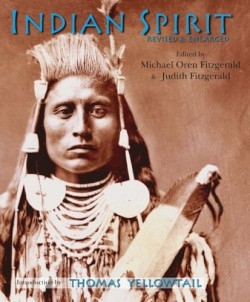Indian Spirit
Revised & Enlarged
This provocative compilation of vintage photographs of Plains Indians and selections of their oratory and writings is the latest publication in the Sacred Worlds series, which seeks to illuminate universal religious themes and traditions.
The Fitzgeralds’ research for this project began while sifting through thousands of photographs in the Library of Congress; they soon realized that since photography was not widely available until the second half of the nineteenth century, there were few photographs from Eastern nomadic tribes. They therefore decided to use only photographs of “men who were raised into manhood during the nomadic days of the Plains Indians, prior to the reservation era.”
The Fitzgeralds included only writings or oratory from elders born before 1904, with the exception of selected writings from the next generation, who were directly taught by those “old-timers.” These quotations are all from male elders; another volume in the series, The Spirit of Indian Women, was published last year.
Beginning in 1970, the Fitzgeralds spent part of every summer, including annual visits to the Sun Dance, with prominent Crow medicine man Thomas Yellowtail, who was an integral link to Native American religion of the past. In the Sun Dance, one or several warriors, their skin painfully pierced, dance around the pole for hours, seeking contact with the Great Spirit. All tribal members share in the fasting and prayer. Yellowtail says that the songs from that ceremony were given to his tribe “before history began,” and link them to the Great Spirit. The words of the elders of numerous other tribes—including Blackfoot, Hopi, Nez Perce, Dwamish, Cheyenne, and Oglala Dakota—also manifest the significance of the Great Spirit in their daily lives—and the stewardship of the Earth that is granted by that Spirit.
“The land comes from the Great Spirit—we cannot sell it because it doesn’t belong to us,” says a Blackfoot chief. “The ground on which we stand is sacred ground. It is the dust and blood of our ancestors,” echoes an Absaroke elder. A Dwamish chief adds, “Every part of this soil is sacred in the estimation of my people … Every hillside, every valley has been hallowed by some sad or happy event in days long vanished.” Threat of removal to reservations, seen in this light, was what drove Chief Joseph, Sitting Bull, and Crazy Horse to take action to avoid losing their ancestral lands. This sentiment is beautifully encapsulated in a Hethushka song: “I shall vanish and be no more, but the land over which I now roam shall remain and change not.”
In a time when many tribes are striving to preserve their language and culture in order to pass it on to their young, this book makes a significant and lasting contribution to that effort.
Reviewed by
Deborah Donovan
Disclosure: This article is not an endorsement, but a review. The publisher of this book provided free copies of the book to have their book reviewed by a professional reviewer. No fee was paid by the publisher for this review. Foreword Reviews only recommends books that we love. Foreword Magazine, Inc. is disclosing this in accordance with the Federal Trade Commission’s 16 CFR, Part 255.

